Duiker William J., Spielvogel Jackson J. The Essential World History
Подождите немного. Документ загружается.

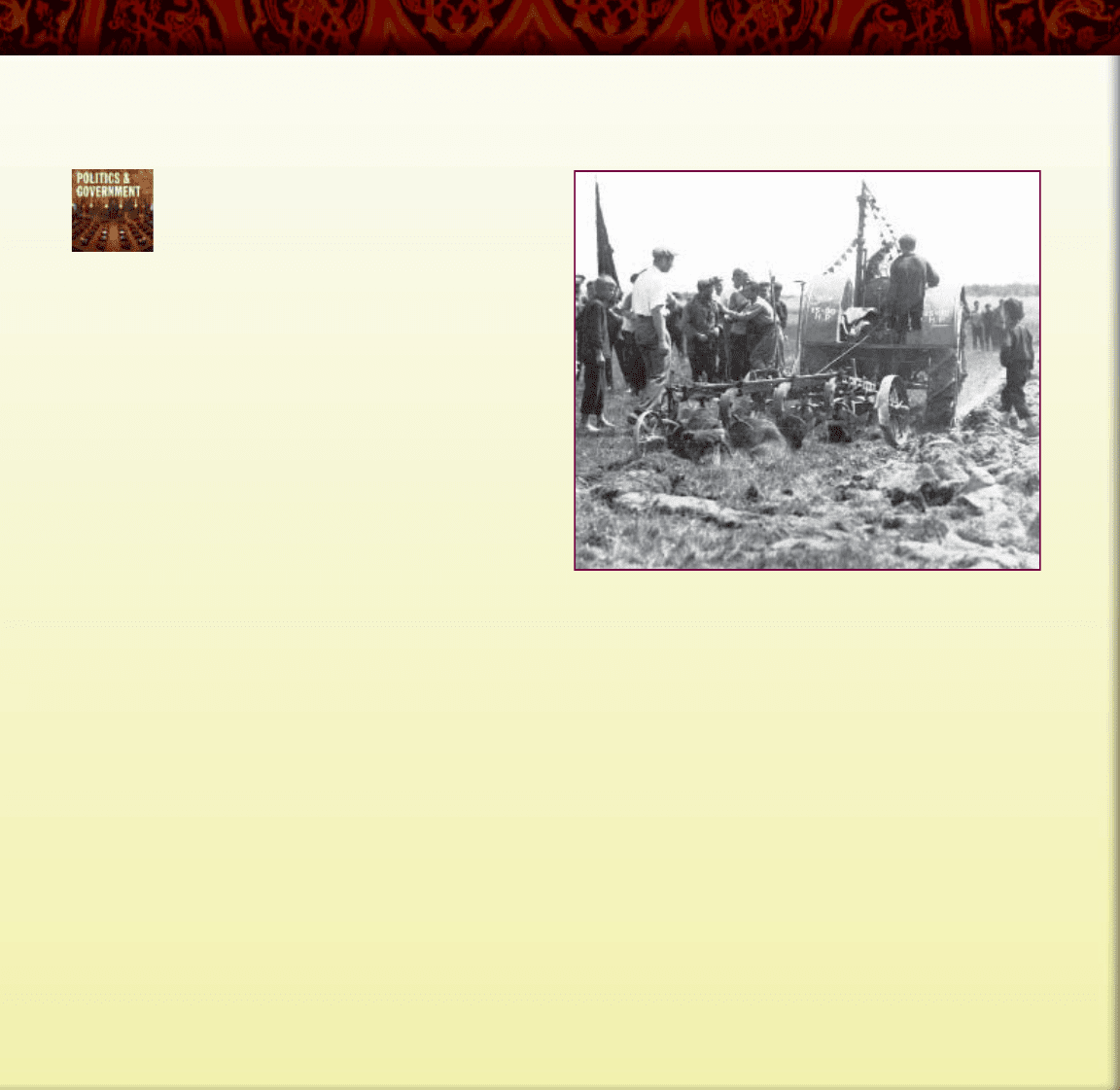
called up for military service. Nazi magazines now pro-
claimed, ‘‘We see the woman as the eternal mother of our
people, but also as the working and fighting comrade of
the man.’’
8
But the number of women working in in-
dustry, agriculture, commerce, and domestic service in-
creased only slightly. The total number of employed
women in September 1944 was 14.9 million, compared
with 14.6 million in May 1939. Many women, especially
those of the middle class, resisted regular employment,
particularly in factories.
Wartime Japan was a highly mobilized society. To
guarantee its control over all national resources, the gov-
ernment set up a planning board to control prices, wages,
the utilization of labor, and the allocation of resources.
COMPARATIVE ESSAY
P
ATHS TO MODERNIZATION
To the casual observer, the most important feature
of the first half of the twentieth century was the
rise of a virulent form of competitive nationalism
that began in Europe and ultimately descended
into the cauldron of two destructive world wars. Behind the
scenes, however, the leading countries were also engaging in
another form of competition over the most effective path to
modernization.
The traditional approach, fostered by an independent urban mer-
chant class, had been adopted by Great Britain, France, and the
United States and led to the emergence of democratic societies on
the capitalist model. A second approach, adopted in the late nine-
teenth century by imperial Germany and Meiji Japan, was carried
out by traditional elites in the absence of a strong independent
bourgeois class. They relied on strong government intervention to
promote the growth of national wealth and power and led ultimately
to the formation of fascist and militarist regimes during the depres-
sion years of the early 1930s.
The third approach, selected by Vladimir Lenin after the
Bolshevik Revolution in 1917, was designed to carry out an indus-
trial revolution without going through an intermediate capitalist
stage. Guided by the Communist Party in the almost total absence
of an urban middle class, this approach envisaged the creation of an
advanced industrial society by destroying the concept of private
property. Although Lenin’s plans ultimately called for the ‘‘withering
of the state,’’ the party adopted totalitarian methods to eliminate en-
emies of the revolution and carry out the changes needed to create a
future classless utopia.
How did these various approaches contribute to the series of
crises that afflicted the world during the first half of the twentieth
century? The democratic-capitalist approach proved to be a consid-
erable success in an economic sense, leading to the creation of ad-
vanced economies that could produce manufactured goods at a rate
never seen before. Societies just beginning to undergo their own
industrial revolutions tried to imitate the success of the capitalist
nations by carrying out their own ‘‘revolutions from above’’ in
Germany and Japan. But the Great Depression and competition over
resources and markets soon led to an intense rivalry between the
established capitalist states and their ambitious late arrivals, a rivalry
that ultimately erupted into global conflict.
In the first decade of the twentieth century, imperial Russia
appeared ready to launch its own bid to join the ranks of the indus-
trialized nations. But that effort was derailed by its entry into World
War I, and before that conflict had come to an end, the Bolsheviks
were in power. Isolated from the capitalist marketplace by mutual
consent, the Soviet Union was able to avoid being dragged into the
Great Depression but, despite Stalin’s efforts, was unsuccessful in
staying out of the ‘‘battle of imperialists’’ that followed at the end of
the 1930s. As World War II came to an end, the stage was set for a
battle of the victors---the United States and the Soviet Union---over
political and ideological supremacy.
Q
What were the three major paths to modernization in the
first half of the twentieth century, and why did they lead to
conflict?
The Soviet Path to Modernization. One aspect of the Soviet effort
to create an advanced industrial society was to collectivize agriculture,
which included a rapid mechanization of food production. Seen here are
peasants watching a new tractor at work.
c
Bettmann/CORBIS
634 CHAPTER 25 THE CRISIS DEEPENS: WORLD WAR II

Traditional habits of obedience and hierarchy, buttressed
by the concept of imperial divinity, were emphasized to
encourage citizens to sacrifice their resources, and some-
times their lives, for the national cause. The system cul-
minated in the final years of the war, when young Japanese
were encouraged to volunteer en masse to serve as pilots
in the suicide missions (known as kamikaze, ‘‘divine
wind’’) against U.S. battleships.
Women’s rights too were to be sacrificed to the
greater national cause. Already by 1937, Japanese women
were being exhorted to fulfill their patriotic duty by
bearing more children and by espousing the slogans of the
Greater Japanese Women’s Association. Japan was ex-
tremely reluctant to mobilize women on behalf of the war
effort, however. General Hideki Tojo, prime minister
from 1941 to 1944, opposed female employment, arguing
that ‘‘the weakening of the family system would be the
weakening of the nation. ... We are able to do our duties
only because we have wives and mothers at home.’’
9
Female employment increased during the war, but only in
areas where women traditionally worked, such as the
textile industry and farming. Instead of using women to
meet labor shortages, the Japanese government brought
in Korean and Chinese laborers.
The Frontline Civilians:
The Bombing of Cities
Bombing was used in World War II against a variety of
targets, including military targets, enemy troops, and
civilian populations. The bombing of civilians made
World War II as devastating for civilians as for frontline
soldiers. A small number of bombing raids in the last year
of World War I had given rise to the argument that public
outcry over the bombing of civilian populations would be
an effective way to coerce governments into making peace.
Consequently, European air forces began to develop long-
range bombers in the 1930s.
The first sustained use of civilian bombing contra-
dicted the theory. Beginning in early September 1940, the
German Luftwaffe subjected London and many other
British cities and towns to nightly air raids, making the
Blitz (as the British called the German air raids) a na-
tional experience. Londoners took the first heavy blows
but kept up their morale, setting the standard for the rest
of the British population (see the comparative illustration
on p. 636).
The British failed to learn from their own experi-
ence, however; Prime Minister Winston Churchill and
his advisers believed that destroying German commu-
nities would break civilian morale and bring victor y.
Major bombing raids began in 1942. On May 31, 1942,
Cologne became the first German city to be subjected to
an attack by a thousand bombers. Bombing raids added
an element o f terror to circumstances already made
difficult by growing shor tages of food, clothing, and
fuel. Germans especially feared incendiar y bombs,
which ignited firestorms that swept destructive paths
through the cities. The ferocious bombing of Dresden
from February 13 t o 15, 1945, set off a firestorm that
mayhavekilledasmanyas35,000inhabitantsand
refugees.
Germany suffered enormously from the Allied
bombi ng raids. Millions of buildin gs were destroyed,
and possibly half a million civilians died from the raids.
Nevertheless, it is highly unlikely that Allied bombing
sapped the morale of the German people. Instead
Germans, whether pro-Nazi or anti-Nazi, foug ht on
stubbornly, often driven simply by a desire to live. Nor
did the bombing destroy Germany’s industrial capacity.
The Allied strategic bombi ng survey revealed tha t the
production of war mat
eriel actually increased between
1942 and 1944.
In Japan, the bombing of civilians reached a hor-
rendous new level with the use of the first atomic bomb.
Attacks on Japanese cities by the new American B-29
Superfortresses, the biggest bombers of the war, had be-
gun on November 24, 1944. By the summer of 1945,
many of Japan’s industries had been destroyed, along with
one-fourth of its dwellings. After the Japanese govern-
ment decreed the mobilization of all people between the
ages of thirteen and sixty into the so-called People’s
Volunteer Corps, President Truman and his advisers de-
cided that Japanese fanaticism might mean a million
American casualties, and Truman decided to drop the
newly developed atomic bomb on Hiroshima and
Nagasaki. The destruction was incredible. Of 76,000
buildings near the hypocenter of the explosion in Hi-
roshima, 70,000 were flattened, and 140,000 of the city’s
400,000 inhabitants had died by the end of 1945. Over the
next five years, another 50,000 perished from the effects
of radiation. The dropping of the atomic bomb on
Hiroshima on August 6, 1945, announced the dawn of the
nuclear age.
Aftermath of the War
Q
Focus Questions: What wer e the costs of World War II?
How did the Allies’ visions of the postwar differ , and
how did these differences contribute to the emergenc e
of the Cold War?
World War II was the most destructive war in history.
Much had been at stake. Nazi Germany followed a
worldview based on racial extermination and the
AFTERMATH OF THE WAR 635
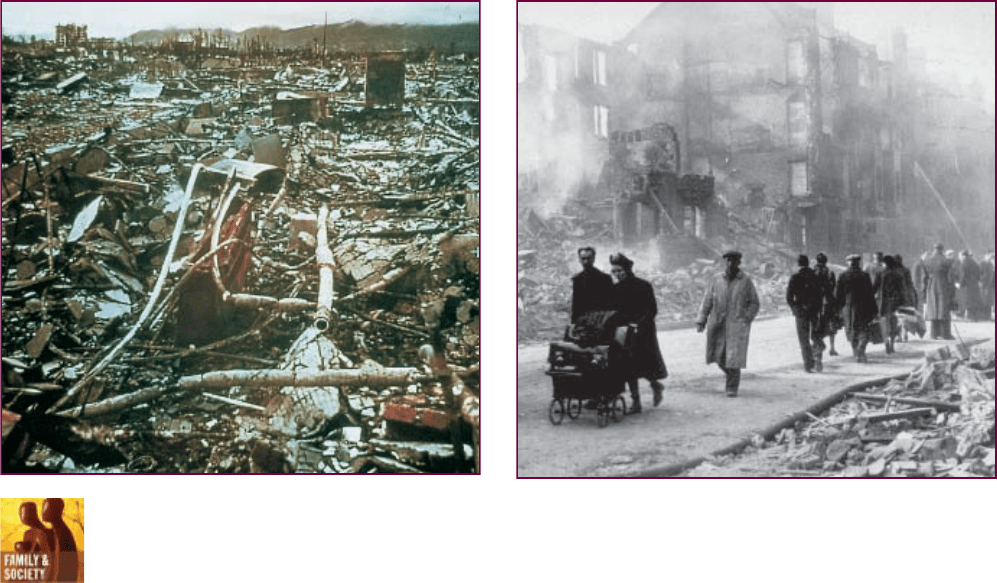
enslavement of millions in order to create an Aryan racial
empire. The Japanese, fueled by extreme nationalist ide-
als, also pursued dreams of empire in Asia that led to
mass murder and untold devastation. Fighting the Axis
Powers in World War II required the mobilization of
millions of ordinary men and women in the Allied
countries who struggled to preserve a different way of life.
As Winston Churchill once put it, ‘‘War is horrible, but
slavery is worse.’’
The Costs of World War II
The costs of World War II were enormous. At least 21
million soldiers died. Civilian deaths were even greater
and are now estimated at around 40 million. Of these,
more than 28 million were Russian and Chinese. The
Soviet Union experienced the greatest losses: 10 million
soldiers and 19 million civilians. In 1945, millions of
people around the world fa ced starvation: in Europe,
100 million people depended on food relief of some
kind.
Millions of people had also been uprooted by the
wa r and became ‘‘displaced persons.’’ Europe alone may
have had 30 million displaced person s, many of whom
found it hard to return home. In Asia, millions of
Japanese were returned from the former Japanese em-
pire to Japan, while thousands of Korean forced laborers
ret urned to Korea.
Everywhere cities lay in ruins. In Europe, the physical
devastation was especially bad in eastern and southeastern
Europe as well as in the cities of western and central
Europe. In Asia, China had experienced extensive devas-
tation from eight years of conflict. So too had the
Philippines, while large sections of the major cities in
Japan had been destroyed in air raids. The total monetary
cost of the war has been estimated at $4 trillion.
COMPARATIVE ILLUSTRATION
The Bombing of Civilians— East and West. World War II was the most
destructive war in world history, not only for frontline soldiers but for civilians at
home as well. The most devastating bombing of civilians came near the end of
World War II when the United States dropped atomic bombs on the Japanese cities of
Hiroshima and Nagasaki. At the left is a view of Hiroshima after the bombing that shows the
incredible devastation produced by the atomic bomb. The picture at the right shows a street in
Clydebank, near Glasgow in Scotland, the day after the city was bombed by the Germans in
March 1941. Only 7 of the city’s 12,000 houses were left undamaged; 35,000 of the 47,000
inhabitants became homeless overnight.
Q
What was the rationale for bombing civilian populations? Did such bombing achieve
its goal?
c
J.R. Eyeman/Time Life Pictures/Getty Images
c
Keyston/Getty Images
636 CHAPTER 25 THE CRISIS DEEPENS: WORLD WAR II
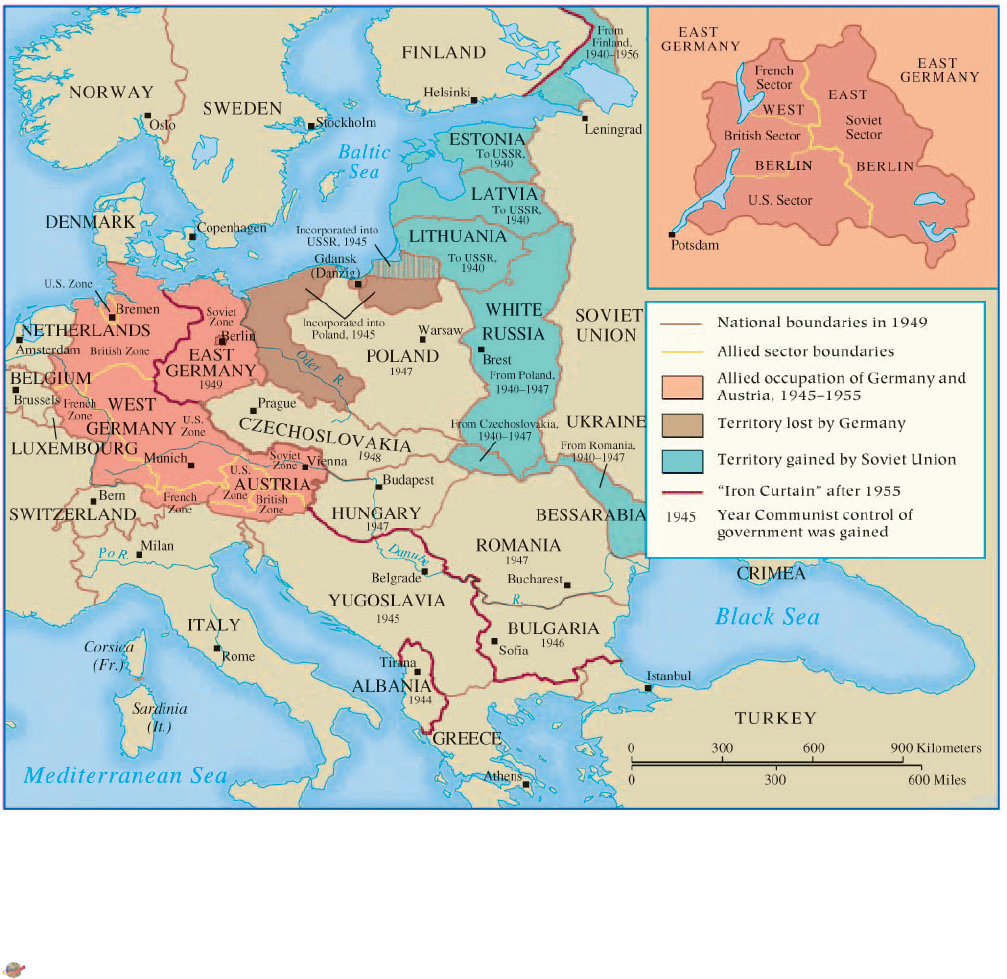
The economies of most belligerents, with the exception of
the United States, were left on the brink of disaster.
The Allied War Conferences
Stalin, Roosevelt, and Churchill, the leaders of the Big
Three of the Grand Alliance, met at Tehran, the capital
of Iran, in November 1943 to decide the future course
of the war. Stalin and Roosevelt argued successfully for
an American-British invasion of the Continent through
France, which they scheduled for the spring of 1944.
This meant that Soviet and British-American forces
would meet in defeated Germany along a north-south
dividing line and that Soviet forces would liberate
eastern Europe. The All ies also agreed to a partition of
postwar Germany.
MAP 25.3 Territorial Changes in Europe After World War II. In the last months of World
War II, the Red Army occupied much of eastern Europe. Stalin sought pro-Soviet satellite
states in the region as a buffer against future invasions from western Europe, whereas Britain
and the United States wanted democratically elected governments. Soviet military control of the
territory settled the question.
Q
Which country gained the greatest territory at the expense of Germany?
View an animated version of this map or related maps at www .cengage.com/history/
duikspiel/essentialworld6e
AFTERMATH OF THE WAR 637

By the time of the conference at Yalta in southern
Russia in Februar y 1945, the defeat of Germany was a
foregone con clusion. The Western powers now faced the
reality of 11 million Red Army soldier s taking posses-
sion of large portions of Europe. Stali n, deeply suspi-
cious of the Western powers, desired a buffer to protect
the Soviet Union from possible future Weste rn aggres-
sion but at t he same time was eager to obtain important
resource s and strategic military positions. Roosevelt
by this time was moving toward th e idea of self-
determination for Europe. The Grand Alliance approved
the ‘‘Declaration on Liberated Europe.’’ This was a pledge
to assist liberated European nations in the creation of
‘‘democratic institutions of their own choice.’’ Liberated
countries were to hold free elections to determine their
political systems.
At Yalta, Roosevelt sought Russian military help
against Japan. Development of the atomic bomb was not
yet assured, and American military planners feared the
possible loss of as many as one million men in invading
the Japanese home islands. Roosevelt therefore agreed
to Stalin’s price for military assistance against Japan:
possession of Sakhalin and the Kurile Islands, as well as
railroad rights in Manchuria.
The creation of the United Nations was a major
American concern at Yalta. Roosevelt hoped to ensure the
participation of the Big Three in a postwar international
organization before difficult issues divided them into
hostile camps. After a number of compromises, both
Churchill and Stalin accepted Roosevelt’s plans for a
United Nations organization and set the first meeting for
San Francisco in April 1945.
The issues of Germany and eastern Europe were
treated less decisively. The Big Three reaffirmed that
Germany mus t surrender unconditionally and created
four occupation zones (see Map 25.3 on p. 637). A
compromise was also worked out in regard to Poland.
Stali n agreed to free elections in the future t o determine
a new government. But the issue of free elections
in eastern Europe caused a serious rift between the
Soviets and the Americans. The principle was that east-
ern European governments would be freely elected, but
they were also supposed to be pro-Russian. This attempt
to reconcile two irreconcilable goals was doomed to
failure, as soon became evident at the next conference of
the Big Three.
The Potsdam conference of July 1945 began under
a cloud of mistrust. Roosevelt had died on April 12 and
had been succeeded as president by Harry Truman. At
Potsdam, Truman demanded free elections throug hout
eastern Euro pe. Stalin responded, ‘‘A freely elected
government in any of these East European countries
would be anti-Soviet, and that we cannot allow.’’
10
After a bitterly fought and devastating war, Stalin
sought absolute military security. To him, it could be
gained only by the pre sence of Communist states in
eastern Europe. Free elections might result in govern-
ments hostile to the Soviets. By the middle of 1945,
only an invasion by We stern forces could undo devel-
opments in eastern Europe, and few people favored
such a policy.
As the war slowly receded into the past, the reality of
conflicting ideologies reappeared (see the comparative
essay on p. 634). Many in the West interpreted Soviet
policy as part of a worldwide Communist conspiracy.
The Soviets, for their part, viewed Western---especially
American---policy as nothing less than global capitalist
expansionism or, in Leninist terms, economic imperial-
ism. In March 1946, in a speech to an American audience,
former British prime minister Winston Churchill de-
clared that ‘‘an iron curtain’’ had ‘‘descended across the
continent,’’ dividing Germany and Europe into two hos-
tile camps. Stalin branded Churchill’s speech a ‘‘call to
war with the Soviet Union.’’ Only months after the
world’s most devastating conflict had ended, the world
seemed once again to be bitterly divided.
CONCLUSION
WORLD WAR II was the most devastating total war in human
history. Germany, Italy, and Japan had been utterly defeated. Perhaps
as many as 60 million people---combatants and civilians---had been
killed in only six years. In Asia and Europe, cities had been reduced to
rubble, and millions of people faced starvation as once fertile lands
stood neglected or wasted.
What were the underlying causes of the war? One direct cause was
the effort by two rising powers, Germany and Japan, to make up for
their relatively late arrival on the scene to carve out global empires. Key
elements in both countries had resented the agreements reached after
the end of World War I, which divided the world in a manner favorable
to their rivals, and hoped to overturn them at the earliest opportunity.
In Germany and Japan, the legacy of a past marked by a strong military
tradition still wielded strong influence over the political system and the
mindset of the entire population. It is no surprise that under the
impact of the Great Depression, which had severe effects in both
countries, militant forces determined to enhance national wealth and
power soon overwhelmed fragile democratic institutions.
Whatever the causes of World War II, the consequences were
soon evident. European hegemony over the world was at an end, and
638 CHAPTER 25 THE CRISIS DEEPENS: WORLD WAR II
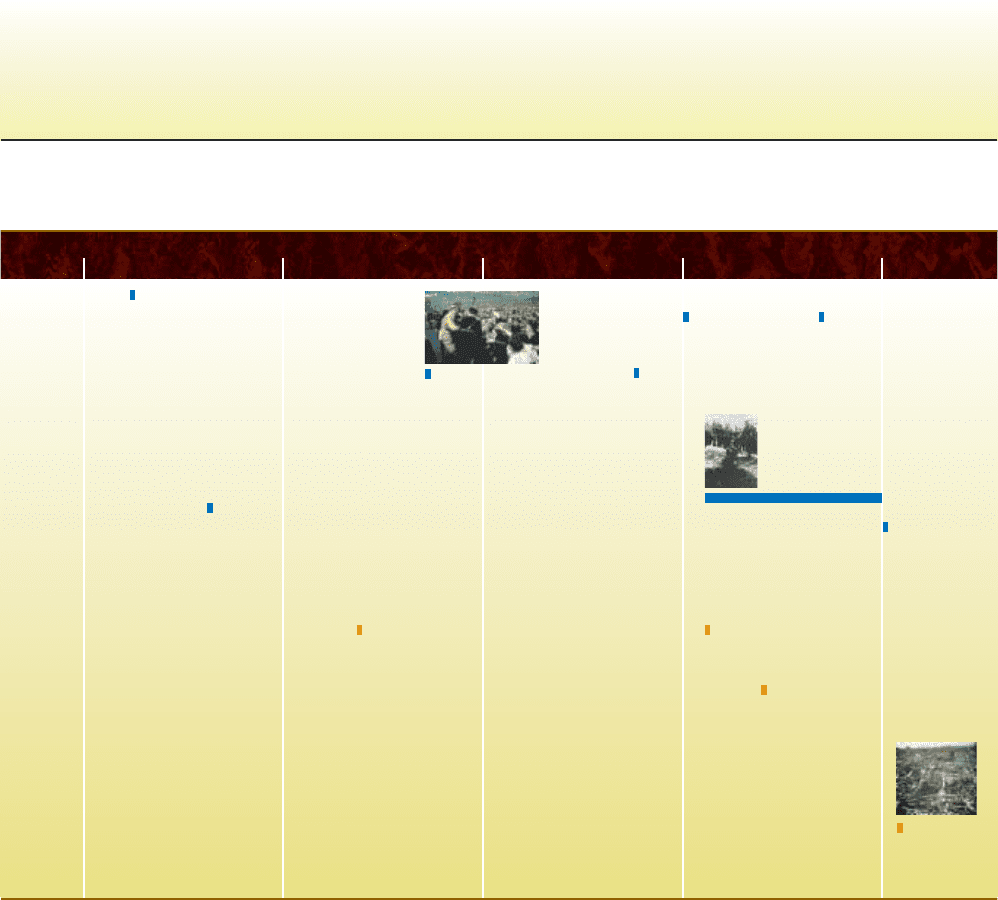
SUGGESTED READING
The Dictatorial Regimes For a general study of fascism,
see S. G. Payne, A History of Fascism (Madison, Wis., 1996), and
R. O. Paxton, The Anatomy of Fascism (New York, 2004). The best
biography of Mussolini is R. J. B. Bosworth, Mussolini (London,
2002). On Fascist Italy, see R. J. B. Bosworth, Mussolini’s Italy: Life
Under the Fascist Dictatorship (New York, 2006).
Two brief but sound surveys of Nazi Germany are J. J.
Spielvogel, Hitler and Nazi Germany: A History, 5th ed. (Upper
Saddle River, N.J., 2005), and W. Benz, A Concise Histor y of the
Third Reich, trans T. Dunlap (Berkeley, Calif., 2006). The best
biography of Hitler is I. Kershaw, Hitler, 1889--1936: Hubris (New
York, 1999), and Hitler: Nemesis (New York, 2000). On the rise of
the Nazis to power, see R. J. Evans, The Coming of the Third Reich
(New York, 2004), and The Third Reich in Power, 1933--1939 (New
York, 2005).
The collectivization of agriculture in the Soviet Union
is examined in S. Fitzpatrick, Stalin’s Peasants: Resistance and
Survival in the Russian Village After Collectiv ization (New York,
1995). Industrialization is covered in H. Kuromiya, Stalin’s
Industrial Revolution: Politics and Workers, 1928--1932 (New York,
1988). On Stalin himself, see R. Service, Stalin: A Biography
(Cambridge, Mass., 2006), and R. W. Thurston, Life and Terror
in Stalin’s Russia, 1934--1941 (New Haven, Conn., 1996).
The Path to War On the causes of World War II, see
A. J. Crozier, Causes of the Second World War (Oxford, 1997).
two new superpowers had emerged on the fringes of Western
civilization to take its place. Even before the last battles had been
fought, the United States and the Soviet Union had arrived at
different visions of the postwar world, and their differences soon led
to the new and potentially even more devastating conflict known as
the Cold War. And even though Europeans seemed merely pawns in
the struggle between the two superpowers, they managed to stage a
remarkable recovery of their own civilization. In Asia, defeated Japan
made a miraculous economic recovery, while the era of European
domination finally came to an end.
TIMELINE
1925
1930 1935 1940 1945
Europe
Asia
Mussolini creates Fascist
dictatorship in Italy
Stalin’s first
five-year plan begins
Japanese attack
on Pearl Harbor
Conferences
at Yalta and
Potsdam
The Holocaust
Japanese takeover of Manchuria
Kristallnacht
Atomic bomb
dropped on
Hiroshima
Hitler and Nazis come
to power in Germany
Fall of France German defeat
at Stalingrad
Japanese create Ministry
for Great East Asia
CONCLUSION 639

On the origins of the war in the Pacific, see A. Iriye, The Origins of
the Second World War in Asia and the Pacific (London, 1987).
World War II General works on World War II include the
comprehensive study by G. Weinberg, A World at A rms: A Global
History of World War II, 2nd ed. (Cambridge, 2005), and
J . Campbell, TheExperienceofWorldWarII(New York, 1989). For
briefer histories, see J. Plowright, Causes, Course, and Outcomes of
World War II (New York, 2007), and M. J. Ly on, World War II: A
Short History , 4th ed. (Upper Saddle River, N.J., 2004).
The Holocaust Excellent studies of the Holocaust include
R. Hilberg, The Destruction of the European Jews, rev. ed., 3 vols.
(New York, 1985); S. Fried
€
ander, The Years of Extermination: Nazi
Germany and the Jews, 1939--1945 (New York, 2007); and L. Yahil,
The Holocaust (New York, 1990). For brief studies, see J. Fischel,
The Holocaust (Westport, Conn., 1998), and D. Dwork and R. J.
van Pelt, Holocaust: A History (New York, 2002).
The Home Front On t he home front in Germany, see
M. Kitchen, Nazi Germany at War (New York, 1995). The Soviet
Union during the war is examined in M. Harrison, Soviet
Planning in Peace and War, 1938-- 1945 (Cambridge, 1985). The
Japanese home front is examined in T. R. H. Havens, The Valley
of Darkness: The Japanese People and World War Two (New
York, 1978).
On the Allied bombing campaign against Germany , see
R. Neillands, The Bomber War: The Allied Air Offensive Against
Nazi Germany (New York, 2005), and J. Friedrich, The Fire: The
Bombing of Germany, trans. A. Brown (New York, 2006). On the use
of the atomic bomb in Japan, see M. Gordin, Five Days in August:
How World War II Became a Nuclear War (Princeton, N.J., 2006).
Emergence of the Cold War On the emergence of the Cold
War, see L. Gaddis, The Cold War: A New History (New York,
2005); J. W. Langdon, A Hard and Bitter Peace: A Global History
of the Cold War (Englewood Cliffs, N.J., 1995); and J. Smith, The
Cold War, 1945--1991 (Oxford, 1998).
Visit the website for The Essential World History to access study
aids such as Flashcards, Critical Thinking Exercises, and
Chapter Quizzes:
www.cengage.com/history/duikspiel/essentialworld6e
640 CHAPTER 25 THE CRISIS DEEPENS: WORLD WAR II
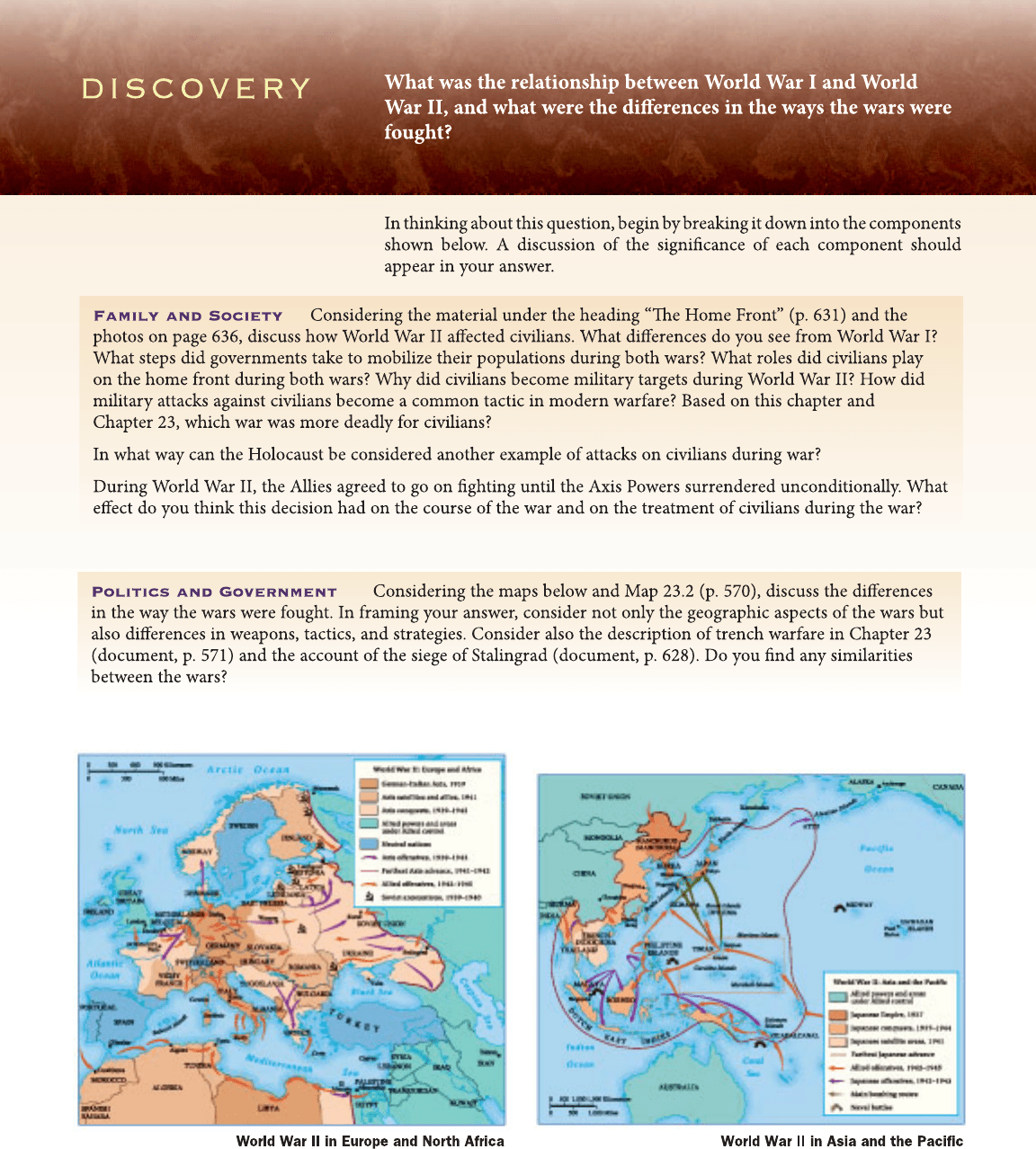
641

PART
V
T
OWARD A
G
LOBAL
C
IVILIZATION
?
T
HE
W
ORLD
S
INCE
1945
26 EAST AND WEST IN THE GRIP
OF THE
COLD WAR
27 BRAVE NEW WORLD:COMMUNISM
ON
TRIAL
28 EUROPE AND THE WESTERN HEMISPHERE
SINCE 1945
29 CHALLENGES OF NATION BUILDING
IN
AFRICA AND THE MIDDLE EAST
30 TOWARD THE PACIFIC CENTURY?
EPILOGUE: AGLOB AL CIVILIZATION
AS WORLD WAR II came to an end, the survivors of that bloody
struggle could afford to face the future with a cautious optimism.
Europeans might hope that the bitter rivalry that had marked relations
among the Western powers would finally be put to an end and that the
wartime alliance of the United States, Great Britain, and the Soviet
Union could be maintained into the postwar era.
More than sixty year s later, these hopes have been only partly
realized. In the decades following the war, the Western capitalist
nations managed to recover from the economic depression that had led
into World War II and adva nced to a level of econo mic prosperity never
seen before. The bloody conflicts that had erupted among European
nations during the first half of the twentieth century came to an end,
and Ge rmany and Japan were fully integrated into the world
community.
At the same time, the prospects for a stable, peaceful world and an
end to balance-of-power politics were hampered by the emergence of a
grueling and sometimes tense ideological struggle between the socialist
and capitalist camps, a competition headed by the only remaining great
powers, the Soviet Union and the United States.
In the shadow of this rivalry, the Western European states made a
remarkable economic recov ery and reached untold levels of prosperity . In
Eastern Europe, Soviet domination, both politically and economically,
seemed so complete that many doubted it could ever be undone. But
communism had never developed deep roots in Eastern Europe, and in
the late 1980s, when Soviet leader Mikhail Gorbachev indicated that his
government would no longer pursue military intervention, Eastern
European states acted quickly to establish their freedom and adopt new
economic structures based on Western models.
Outside the West, the peoples of Africa and Asia had their own
reasons for optimism as World War II came to a close. In the Atlantic
Charter, Franklin Roosev elt and Winston Churchill had set forth a joint
declaration of their peace aims calling for the self-determination of all
peoples and self-government and sovereign rights for all nations that had
been deprived of them.
As it turned out, some colonial powers were reluctant to divest
themselves of their colonies. Still, World War II had severely undermined
the stability of the colonial order, and by the end of the 1940s, most
colonies in Asia had received their independence. Africa follo wed a decade
or two later .
Broadly speaking, the leaders of these newly liberated countries set
forth three goals at the outset of independence. They wanted to throw off
the shackles of Western economic domination and ensure material
prosperity for all of their citizens. They wanted to introduce new po-
litical institutions that would enhance the right of self-determination of
their peoples. And they wanted to develop a sense of common nation-
hood within the population and establish secure territorial boundaries.
Most opted to follow a capitalist or a moderately socialist path toward
economic development. In a few cases---most notably in China and
Vietnam---revolutionary leaders opted for the Communist mode of
development.
Regardless of the path chosen, the results were often disappointing.
Much of Africa and Asia remained economically dependent on the
642

advanced industrial nations. Some societies faced severe problems of
urban and rural poverty.
What had happened to tarnish the bright dream of economic
affluence? During the late 1950s and early 1960s, one school of thought
was dominant among scholars and government officials in the United
States. Known as modernization theory, this school took the view that the
problems faced by the newly independent countries were a consequence of
the difficult transition from a traditional to a modern society. Moderni-
zation theorists were convinced that agrarian countries were destined to
follow the path of the West toward the creation of modern industrial
societies but would need time as well as substantial amounts of economic
and technological assistance from the West to complete the journey.
Eventu ally, modernization theory began to come under attack from a
new generation of younger scholars. In their view, the responsibility for
continued economic underdevelopment in the developing world lay not
with the countries themselves but with their continued domination by the
ex-colonial powers. In this view , kno wn as dependency theory , the coun-
tries of Asia, Africa, and Latin America were the victims of the international
marketplace, which charged high prices for the manufactured goods of the
West while dooming preindustrial countries to low prices for their own raw
material exports. Efforts by such countries to build up their own industrial
sectors and move into the stage of self-sustaining growth were hampered by
foreign control---through Eur opean- and American-o wned corporations---
over many of their resources. To end this ‘‘neocolonial’’ relationship, the
dependency theory advocates argued, developing societies should reduce
their economic ties with the West and practic e a policy of economic self-
reliance, thereby taking control over their own destinies.
Leaders of African and Asian countries also encountered problems
creating new political cultures responsive to the needs of their citizens.
At first, most accepted the concept of democracy as the defining theme
of that culture. Within a decade, howev er, democratic systems through-
out the developing world were replaced by military dictatorships or one-
party governments that redefined the concept of democracy to fit their
own preferences. It was clear that the difficulties in building democratic
political institutions in developing societies had been underestimated.
The problem of establishing a common national identity has in
some ways been the most daunting of all the challenges facing the new
nations of Asia and Africa. Many of these new states were a composite of a
wide variety of ethnic, religious, and linguistic groups who found it dif-
ficult to agree on common symbols of nationalism. Problems of estab-
lishing an official language and delineating territorial boundaries left over
from the colonial era created difficulties in many countries. Internal
conflicts spawned by deep-rooted historical and ethnic hatreds have
proliferated throughout the world, leading to a vast new movement of
people across state boundaries equal to any that has occurred since the
great population migrations of the thirteenth and fourteenth centuries.
The introduction of Western cultural values and customs has also had
a destabilizing effect in man y areas. Although such ideas are welcomed by
some groups, they are firmly resisted by others. Where Western influence
has the effect of undermining traditional customs and religious beliefs, it
often provokes violent hostility and sparks tension and even conflict within
individual societies. Much of the anger recently directed at the United States
in M uslim countries has undoubtedly been generated by such feelings.
Nonetheless, social and political attitudes are changing rapidly in
many Asian and African countries as new economic circumstances have
led to a more secular worldview, a decline in traditional hierarchical
relations, and a more open attitude toward sexual practices. In part, these
changes have been a consequence of the influence of Western music,
movies, and television. But they are also a product of the growth of an
affluent middle class in many societies of Asia and Africa.
Today we live not only in a world economy but in a world society,
where a revolution in the Middle East can cause a rise in the price of oil in
the United States and a change in social behavior in Malaysia and Indo-
nesia, where the collapse of an empire in Asia can send shock waves as far
as Hanoi and Havana, and where a terrorist attack in New York City or
London can disrupt financial markets around the world.
c William J. Duiker
TOWAR D A GLO B AL CIVILIZATION?THE WORLD SINCE 1945 643
